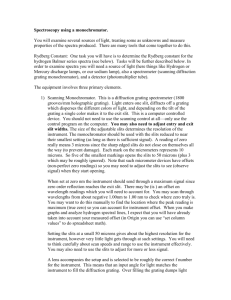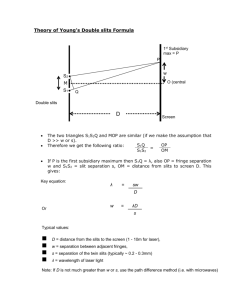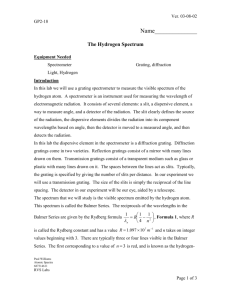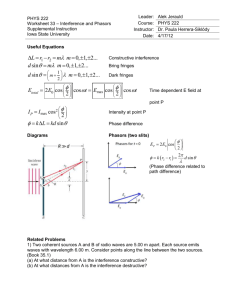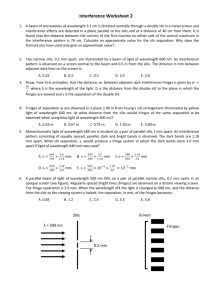Rydberg Constant:
advertisement
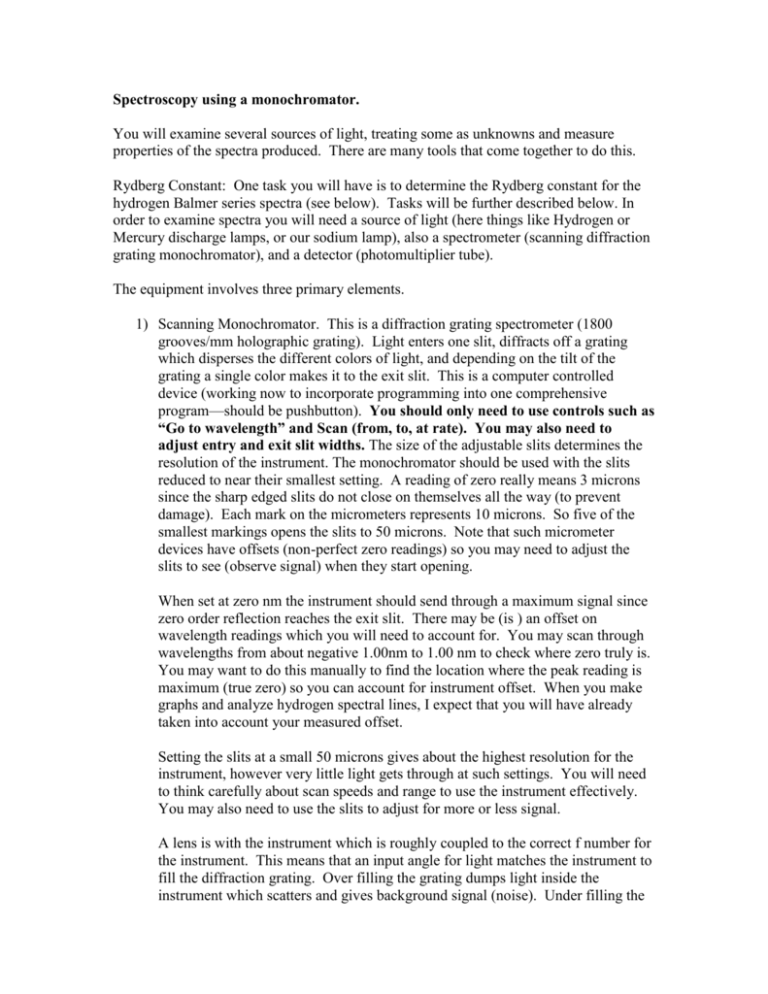
Spectroscopy using a monochromator. You will examine several sources of light, treating some as unknowns and measure properties of the spectra produced. There are many tools that come together to do this. Rydberg Constant: One task you will have is to determine the Rydberg constant for the hydrogen Balmer series spectra (see below). Tasks will be further described below. In order to examine spectra you will need a source of light (here things like Hydrogen or Mercury discharge lamps, or our sodium lamp), also a spectrometer (scanning diffraction grating monochromator), and a detector (photomultiplier tube). The equipment involves three primary elements. 1) Scanning Monochromator. This is a diffraction grating spectrometer (1800 grooves/mm holographic grating). Light enters one slit, diffracts off a grating which disperses the different colors of light, and depending on the tilt of the grating a single color makes it to the exit slit. This is a computer controlled device (working now to incorporate programming into one comprehensive program—should be pushbutton). You should only need to use controls such as “Go to wavelength” and Scan (from, to, at rate). You may also need to adjust entry and exit slit widths. The size of the adjustable slits determines the resolution of the instrument. The monochromator should be used with the slits reduced to near their smallest setting. A reading of zero really means 3 microns since the sharp edged slits do not close on themselves all the way (to prevent damage). Each mark on the micrometers represents 10 microns. So five of the smallest markings opens the slits to 50 microns. Note that such micrometer devices have offsets (non-perfect zero readings) so you may need to adjust the slits to see (observe signal) when they start opening. When set at zero nm the instrument should send through a maximum signal since zero order reflection reaches the exit slit. There may be (is ) an offset on wavelength readings which you will need to account for. You may scan through wavelengths from about negative 1.00nm to 1.00 nm to check where zero truly is. You may want to do this manually to find the location where the peak reading is maximum (true zero) so you can account for instrument offset. When you make graphs and analyze hydrogen spectral lines, I expect that you will have already taken into account your measured offset. Setting the slits at a small 50 microns gives about the highest resolution for the instrument, however very little light gets through at such settings. You will need to think carefully about scan speeds and range to use the instrument effectively. You may also need to use the slits to adjust for more or less signal. A lens is with the instrument which is roughly coupled to the correct f number for the instrument. This means that an input angle for light matches the instrument to fill the diffraction grating. Over filling the grating dumps light inside the instrument which scatters and gives background signal (noise). Under filling the grating uses fewer diffraction grooves and hence gives broader diffraction maximums, hence less resolution. The lens placement will be roughly determined for you and is approximately 12-13 cm from the slit assembly. A light source will need to be an appropriate distance to form an image on the slits. Some minor adjustments of the lens and light source are expected. You should make sure that you are able to see an image of your light source well centered on the slits. Since you will need to move light sources you will need to check on the optical alignment (object—lens—image). 2) A detector is mounted on the exit of the monochromator. There is also a mechanical shutter (up is open, down closed). The photomultiplier tube (PMT) is a very sensitive device which is capable of detecting single photons and multiplying through photons and then electrons impinging on materials that eject many electrons for each incident. The current produced is detectable with other instruments such as a lockin amplifier or piccoammeter (item 3). The photomultiplier requires powering in order to amplify. The setting on the power supply for the PMT is often set at -1000Volts. In general do not adjust beyond 1200. Lower voltages may be used---however if one is doing spectroscopy where the intensity must be known, then the voltage must remain constant throughout the experiment. The response of PMT to different colors is also an issue to consider. You may need to check and adjust the PMT power supply voltage to increase or reduce signal level—however you may use negative 1.00kVolt as a good benchmark, and use monochromator slits to adjust signal first (smaller slits is certainly OK). Under no circumstances should you open the monochromator or the PMT housings. If you notice an overload signal (red lights ---then reduce the slit width first, and the PMT voltage second). 3) The third instrument we use (other than our light source and a computer) is the SR810 digital lockin amplifier. Think of this as a very fancy voltmeter. In our case we will set it to read small currents. In general the output of the PMT should not be greater than about 2.00 microAmps. Using the lockin amplifier a signal of a few nA is detectable. The usable signal on the lockin will probably be on the order of tens of nanoAmps. A chopper wheel is used to introduce a frequency into the desired signal (the chopper must be placed in the light path between the lens and entry slits), the lockin is then able to reject any noise which does not have that same frequency (thermal, background light, electrical, etc). The lockin is a very powerful piece of equipment. The chopper may be set at roughly a few hundred Hz (as long as not a multiple of 60Hz line noise)—lets say 280Hz. The phase between the chopper reference must be synchronized with the signal—hit “autophase” once you have some signal. The source should be on current I x106 and you will need to select the appropriate sensitivity scale (this depends on your signal level). The time constant (think RC smoothing and also FFT integration time) is adjustable ---as a guess something on the order of 100ms should be appropriate. Note this goes into thinking about your scan speed!!!!!!!!!!!!! You must take at least a time constant to scan through a wavelength range which you want to resolve. The computer should be displaying a chart of current (signal intensity) vs wavelength (time or point number or wavelength are all the same---you may need to convert). If your monochromator can observe approx 0.05 nm, then you should not scan faster than 0.05nm in 0.1 s (the time const) if you want full resolution. So in general with these settings never faster than 30nm/minute on the monochromator. There are many other settings on the lockin apmplifier which will be preset to examine signal in these experiments. As you take data you will end up with scans of intensity (proportional to intensity) vs wavelength. These will be sent as data with both intensity and wavelength in a *.csv or *.txt file---which origin or other software can import. There will be big picture scans (fast through entire spectrum) and also zoom in scans on a narrow feature (slow through individual spectral lines). The goal of fast scans is to see where specific intense spectral features are located. So for example, in hydrogen you will want to scan from about 400nm to 700nm and look for 4 intense features. Then you will want to scan slowly through each feature and get a high resolution (slow with lots of samples) scan so that you can determine the peak wavelengths. For each spectral feature you analyze you will make a graph which you can analyze with a peak wavelength and a linewidth. This width is a convolution of the instrument resolution and the true width of the spectral feature. For example –the width of a HeNe laser line (light scattered off a note card into the monochromator) should appear to be a delta function with very narrow width, but will appear to be about 0.05 to 0.1 nm due to the limitations of the instrument resolution. Several factors influence the width and the intensity of spectral features. TASKS 1) With any source determine the zero wavelength for the monochromator. (find the peak near zero it should be within a few tenths of nm). 2) Verify that the sodium lines are where you expect (given any offset). Both these lines will fit on a single scan. 3) Detailed long range and narrow focus scans for the 4 visible Balmer series spectral lines (long slow scan should tell you where to look, then zoom in for each spectral line). 4) Other----Things for you to consider ? Other source (ask)? Instrument resolution (measure)? Detailed discussion of analysis and spectral features? ? relative intensity and instrument intensity calibration? Absorption spectra? Properties of diffraction gratings in such spectrometers. Instrument control. Or??????? You will use the scanning monochromator, a photomultiplier tube (very sensitive detector), and an electrometer (to measure small detector currents). You will examine the spectral output from a Hydrogen discharge tube. The tube emits light due to excitation of hydrogen atoms and also hydrogen molecules. The geometry of the tube is set up so that the electrical discharge eliminates most of the H2, thus reducing the relative intensity of the molecular spectra. What remains is largely hydrogen Balmer series lines. You will scan and observe the peak wavelengths for the Balmer series lines in Hydrogen. Observe as many as possible (four are likely). The Balmer series has transitions from upper states (n) to a final state of 2. (Eq 11.2 page 126 , Essentials of Modeer Physics, T.R. Sandin). 1 1 1 1.097 x10 7 m 1 2 2 n i 2 The constant displayed is the Rydberg constant. You will use your data to determine this constant. This requires measurement of the wavelengths for several peaks of intensity output from the hydrogen lamp. Then you will make an appropriate plot to determine the Rydberg Constant. Remember to use the sensitivity adjustment on the lockin, or the monochromator slits, or the PMT voltage to ensure that the signal does not overload the lockin amplifier.
